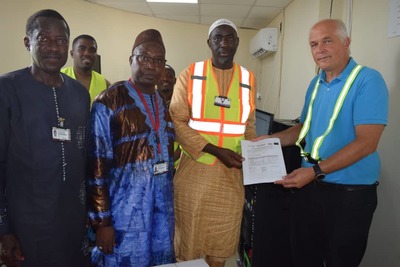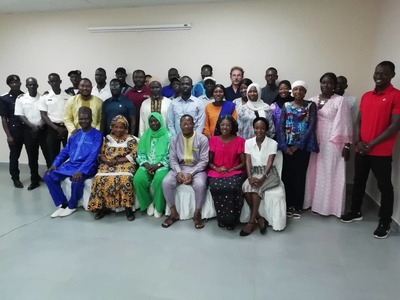DEPARTMENT OF WATER RESOURCES SEASONAL RAINFALL PREDICTION FOR JULY-AUGUST- SEPTEMBER (JAS) 2022 & SOCIO-ECONOMIC IMPLICATIONS FOR THE GAMBIA

The Department of Water Resources (DWR) produces the Seasonal Rainfall Prediction (SRP) annually in fulfilment of its statutory responsibility to advise the Government and people of The Gambia on all aspects of weather and climate. The SRP gives the outlook of rainfall patterns in The Gambia for the period July-August-September (JAS). DWR produces these forecasts using state-of-the-art forecasting tools and contemporary scientific knowledge. The information presented in the SRP publication is relevant for policy formulation, planning and decision making by operators, stakeholders, and individuals in both private and public sectors in The Gambia. The forecast is particularly useful for operators in weather-sensitive sectors such as agriculture, aviation, construction, water resources, disaster risk reduction, health, energy, trade and tourism, amongst others.
As in the previous years, the prediction was based on the strong teleconnection between El Nino/ Southern Oscillation (ENSO) and Sea Surface Temperature (SST) anomalies over the Central Pacific Ocean (Nino 3.4 region) and Tropical North Atlantic Ocean and the rain-bearing systems over The Gambia.
On the inter-annual to seasonal time scales, the variability of sea surface temperature in the equatorial Pacific (El Nino / La Nina), tropical Atlantic and Indian Oceans influence rainfall during the period July-August - September in West Africa and particularly the Sahel.
La Nina (or El Nino) conditions often coincide with the wet (dry) summer season over most of the Sahel.
When the Gulf of Guinea is warm (or cool) during April-May-June-July, it is favourable for wet conditions (or dry) over the adjacent countries.
When the tropical Atlantic is cold north of the Equator and warm South of it (or warm in the north and cold in the south), it is favourable for dry conditions (or wet) in the Sahel and wet conditions (dry) over the Gulf of Guinea countries.
The variations in sea surface temperature of the Indian Ocean influence rainfall over the eastern part of the Sahel (Chad, Sudan). Warming to the west of the Indian Ocean off the coast of East Africa is expected to favour a wet summer season over the eastern Sahel.
JAS 2022 Rainfall Prediction
For the coming July-August-September period, considerable variations in the amount of rainfall in the various places over the country are expected .
The predicted rainfall amount over the country is predicted very likely to be above average to likely average rainfall for the period of July-August-September (JAS) over the Gambia. The interpretation of that means the country’s average is expected to have rainfall quantity equal to or more than 1000mm in the western sector of the country. Amount in the range of 700 - 900mm is likely over the rest of the country.
The predicted 2022 rainfall values would therefore be above normal over large areas of the country. The latest figures indicate a 45% chance of above-normal rainfall, 35% chance of near-normal rainfall and 20% chance for below-normal rainfall. Put in simpler terms, this means that the chance of having above-normal rainfall is higher than the chance of having a normal rainfall.
Furthermore, it is worthy of note that the 2022 rainfall season is expected to undergo more variability than the 2021 season with events such as early to normal onset, late or normal withdrawal of rains and short to average dry spells. Accordingly, this department will undertake to provide weekly climate and short to medium range weather forecasts to better anticipate the impacts of intra-seasonal climate events.
Beginning of the farming season (Onset)
In an agrarian economy like in The Gambia, where rain fed-agriculture is predominant, rainfall onset for the commencement of the farming season is crucial. It affects the establishment of crops, agricultural production and subsequently, national economies. Failure in the timely establishment of rainfall onset usually affects farmers. It is essential that, after a given date, the rain will become fairly continuous and sufficient to provide adequate soil moisture for and after planting is maintained as the season advances for the successful establishment of crops.
In 2022, The Gambia is expected to see rainfall onset between 12th June and 18th June as illustrated in figure 2 below. These dates are expected to be generally early by up to 2 weeks over large parts of the country. Judicious use of these predictions in planning agricultural activities will lead to safe sowing and enhanced crop and food production. This information should be widely available to extension services and agencies that have the responsibility of advising farmers on the appropriate time of planting and varieties to be planted.
A longer than normal length of the season is predicted for most parts of the country. It is expected to be in the range of 120-130 days.
Short to medium-dry sequences are expected at the start of the rain season in most parts of the country
The Flow at the River Gambia is expected to be normal to above normal flow.
POTENTIAL SOCIO-ECONOMIC IMPLICATIONS OF 2022 SEASONAL RAINFALL PREDICTION.
Hazards Associated with 2022 Seasonal Rainfall Prediction
- Early to Near normal onset very likely over much of the country
- late to normal end dates
- Dry spells during the season;
- Normal to Above Normal River flow
For the agriculture sector
In view of the generally wet nature expected of the 2022 rainy season in The Gambia and shorter to average dry spell, it is recommended that farmers, herders, water resource managers, projects, NGOs and authorities:
- Invest more in high-yielding crops tolerant of wet conditions (rice, sugar cane, tubers, etc.)
- Exploit situations of average to above-average flows by developing irrigated crops, particularly in the floodplains of the River Gambia, while taking care of the risks of flooding,
- Set up systems for the collection and conservation of runoff water for agricultural and domestic uses in the dry season,
- Support the deployment of climate-smart techniques to increase crop and fodder yields, in particular those related to above-average rainwater,
- Strengthen the information, supervision and agro-hydro-meteorological assistance systems for farmers;
- Facilitate farmers' access to improved seeds and agricultural inputs adapted to their needs,
- Prioritize high land areas for planting particularly areas along the River Gambia.
Disaster Management Sector
The overall rainy character expected for the 2022 rainy season in The Gambia, presages the high risk of flooding that can lead to losses of crops, material goods and animal and human lives in exposed localities. To deal with this, it is recommended to:
- Strengthen the communication of seasonal forecasts and their updates in order to inform, sensitize communities on the risks and create the conditions for their shelter, in particular through the support of the press, disaster risk reduction platforms and NGOs,
- Strengthen the monitoring and response capacities of agencies in charge of flood
monitoring, disaster risk reduction and humanitarian aid,
- Avoid the uncontrolled occupation of flood-prone areas with habitations and crops,
- Strengthen protective dikes and ensure the maintenance of bridges and road infrastructure,
- Clean sewer channels to facilitate the evacuation of rainwater,
- Closely monitor the alert thresholds in areas at high risk of flooding, particularly in the riverine areas;
- Provide reception sites for populations exposed to the disaster,
- Promote the cultivation of plants adapted to the persistence of excess water in the soil
- Closely follow the updates of these seasonal forecasts and the short and medium-range forecasts produced and disseminated by the Department of Water Resources,
- Conduct simulation exercises as part of the preparation of flood response plans
3.0 Faced with the risk of drought
With the expected normally to below normal rainfall for the 2021 rainy season, long dry spells expected at the start of the season could delay the installation of crops and fodder biomass over most places. The water deficits can indeed lead to planting failures, affect the plant growth, promote the development of insect pests in crops, delay the return of transhumant to the North, prolong the lean season for animals and cause conflicts between breeders and farmers. To prevent these risks, it is recommended to:
- Diversify agricultural practices, in particular through the adoption of techniques for managing water on the plot and promoting irrigation and market gardening to reduce the risk of production in exposed areas;
- Set up stocks of livestock feed,
- Prevent conflicts, by sensitizing pastoralists and farmers
- Strengthening the monitoring and guidance of the movements of breeders in the search for pastures and water points,
- Build capacity of crop protection services to intervene in the event of outbreaks of crop pests,
- Ensure integrated management of water resources for a better consideration of the different uses, in particular the needs of hydro-electric dams and hydro-agricultural facilities,
- Farmers to interact with the technicians from the Department of Water Resources, Department of Agriculture and Crop Protection Department for agro-hydro meteorological advice on what to do;
Regarding health risks
Wetlands and flooded areas can be subject to the development of water-related diseases (Cholera, malaria, diarrhoea, etc.). To this end, it is strongly recommended to:
- Raise awareness of climate-sensitive diseases, in collaboration with meteorological, hydrological and health services,
- Vaccinate people and animals, encourage the use of mosquito nets, set up stocks of medicine for curative treatments, especially in areas that will be difficult access following floods,
- Monitor water quality and set up stocks of treatment products
- Clean up agglomerations and avoid contact with contaminated water, through drainage and gutter cleaning operations;
- Strengthen the capacities of national health systems and disaster risk reduction platforms,
- Increase vigilance against diseases and pests of crops (armyworm and other insect pests);
Conclusion
A forecast is just a set of probabilities attached to a set of future events. In order to understand a forecast, all one needs to do is to interpret those bits of information. Unfortunately, there are problems in communicating each element, so that the user of a forecast understands what its producer means.
Following the consistency between the seasonal forecast probabilities and the observed rainfall that has been issued since 1998, we are recommending that the JAS seasonal forecast issued each year in the month of May be used by the policymakers as early warning information.
Timely climate information can lead to important decisions by producers that can dramatically increase productivity windows of opportunity.
Armed with Climate information, important decisions can be made on amounts of food to store for food reserve and excess for sale as envisaged in National Development Plan 2018 - 2021.
Pleased to inform the Cabinet and all those involved in monitoring the agricultural production that the update of the 2022 seasonal rainfall prediction will be made by the Department of Water Resources at the end of June 2022.


